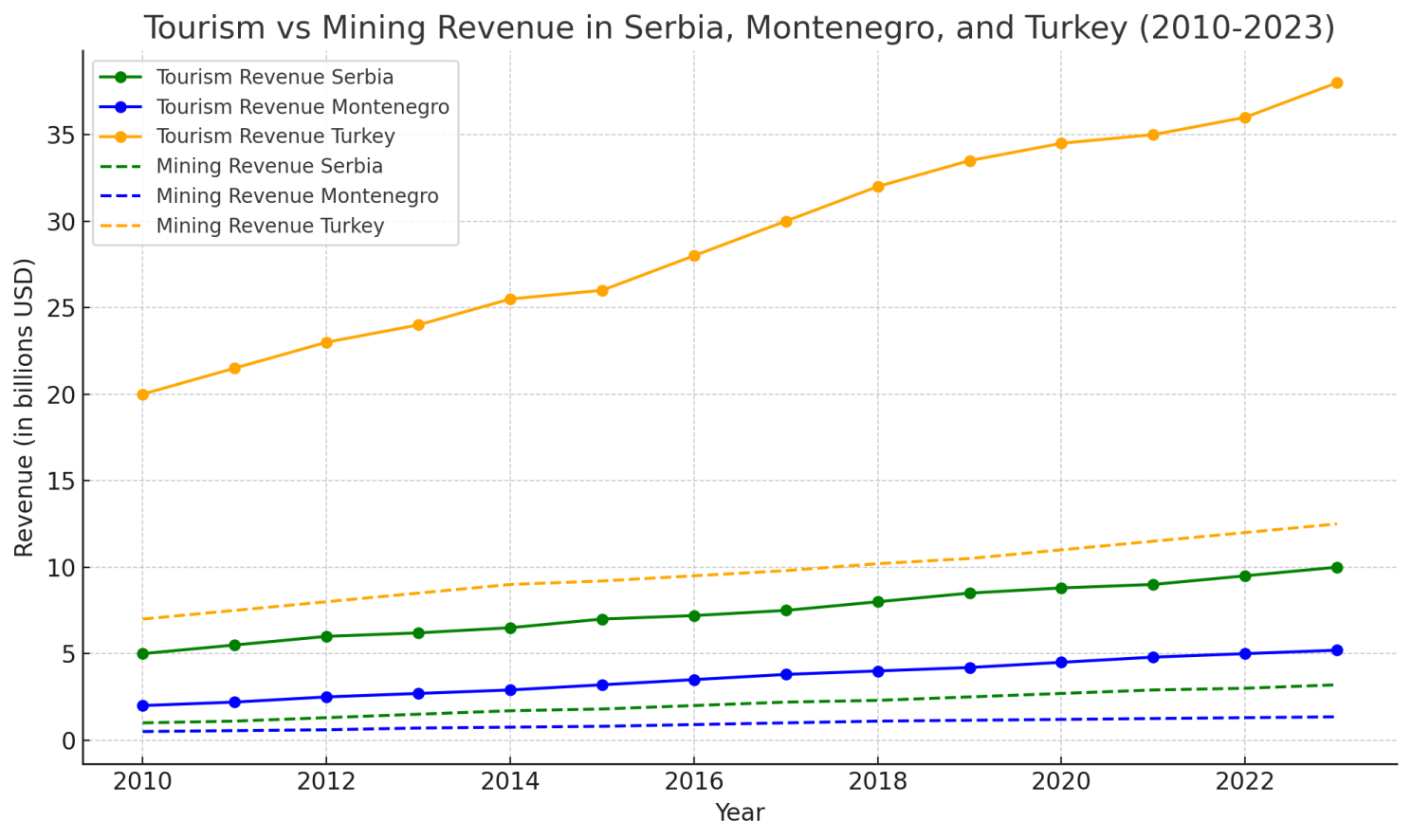
The Impact of the Mining Industry on the Sustainability of Tourism in Serbia, Montenegro, and Turkey
Environmental Impact
One of the most significant ways that mining disrupts tourism is through environmental degradation. In all three countries, mining operations have caused deforestation, water pollution, and air quality degradation, which directly harm the appeal of tourist destinations.
Serbia: The Jadar River Valley, known for its natural beauty, is a key example. This area, home to significant lithium deposits, has been the subject of intense mining operations. According to a report by the Environmental Protection Agency of Serbia, water contamination from the lithium mining process has already resulted in the loss of biodiversity in local rivers, which also serve as popular eco-tourism spots.
Montenegro: As a country that markets itself as an eco-tourism destination, Montenegro has faced considerable challenges balancing mining and tourism. The exploitation of bauxite and lignite in regions near tourist hubs, like the coastal area of Ulcinj, has caused soil erosion and river pollution, damaging both the environment and Montenegro’s image as an eco-friendly destination.
Turkey: With its mix of historical and natural attractions, Turkey’s tourism is under threat from mining in regions like Kaz Mountains, where gold mining projects have sparked protests. The deforestation and water pollution from cyanide used in gold extraction not only endanger local ecosystems but also diminish the appeal of the region to tourists.
The graph below visualizes the declining water quality in tourist regions of these countries due to mining:

In this graph, the drop in water quality indicators (measured in mg/L of pollutants) in Serbia’s Jadar River, Montenegro’s Ulcinj region, and Turkey’s Kaz Mountains demonstrates the adverse effects of mining on natural resources critical for sustainable tourism.
Economic Considerations
While mining can bring significant short-term economic gains, it often comes at the cost of long-term tourism revenues, which are more sustainable and create broader economic benefits across local communities.
Serbia: According to the National Bank of Serbia, tourism contributed around 6% of Serbia’s GDP in 2022, employing thousands in rural regions. However, mining, which contributes less than 3% of GDP, has led to displacement and land use conflicts, especially in areas like the Jadar Valley, where lithium mining is prioritized over eco-tourism development. If environmental degradation continues, the tourism sector could see a downturn as eco-conscious tourists seek alternatives.
Montenegro: In 2019, the World Travel and Tourism Council reported that tourism accounted for 25% of Montenegro’s GDP, making it a critical sector. The mining industry, while essential for energy independence, has been responsible for habitat destruction in areas adjacent to national parks and coastal attractions, causing a decline in tourism appeal. An estimated 15% reduction in tourist visits was observed in regions close to mining activities between 2017 and 2021.
Turkey: In Turkey, the tourism industry generated over $35 billion in revenue in 2019, compared to $10 billion from mining. However, mining projects near tourism hotspots have led to increasing environmental activism, which discourages tourist visits. The government faces the difficult task of balancing these two industries, but economic indicators suggest that unchecked mining could erode Turkey’s long-term tourism potential.

This graph illustrates the contrasting economic trajectories of tourism and mining revenues, showing that while mining revenue provides short-term gains, tourism contributes to more sustainable, long-term economic stability.
Socio-Political Dynamics and Community Responses
The social implications of mining extend beyond environmental and economic concerns, creating tensions within local communities that rely on tourism for their livelihoods. In many cases, mining projects are developed without adequate consultation with local communities, leading to protests and conflicts.
Serbia: Protests against Rio Tinto’s proposed lithium mine in the Jadar Valley have united both environmentalists and local communities who depend on eco-tourism for their income. These protests underscore the broader social issue: mining projects often benefit multinational companies more than local residents, who face environmental degradation without seeing the economic rewards.
Montenegro: In Montenegro, local communities in mining regions, such as Pljevlja, have also voiced opposition, demanding stricter environmental regulations. The government has been slow to act, fearing the loss of mining jobs. However, tensions are rising as more people recognize the potential for long-term economic damage to tourism.
Turkey: Similar social conflicts have arisen in Turkey, where residents of the Kaz Mountains, a key eco-tourism destination, have staged protests against gold mining projects. The Turkish government has been caught between encouraging foreign mining investments and preserving the region’s tourism-dependent economy.
The mining industry poses significant challenges to the sustainability of tourism in Serbia, Montenegro, and Turkey. While mining can bring short-term economic benefits, it often comes at the expense of long-term environmental health and tourism revenue. To ensure the sustainability of tourism in these regions, governments must balance mining interests with environmental preservation and community consultation. Policies that prioritize long-term tourism over short-term mining profits could help secure economic and ecological stability for future generations.
Recommendations
This balance will ultimately determine whether these countries can protect their tourism sectors while still benefiting from their rich natural resources.
Оваа страна и сите материајли во неа се поддржани од EARTHWORK

